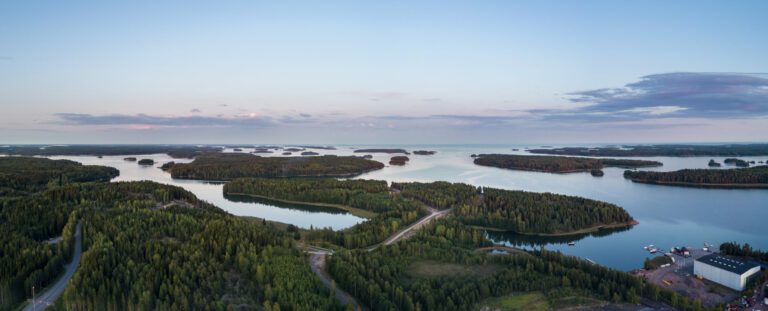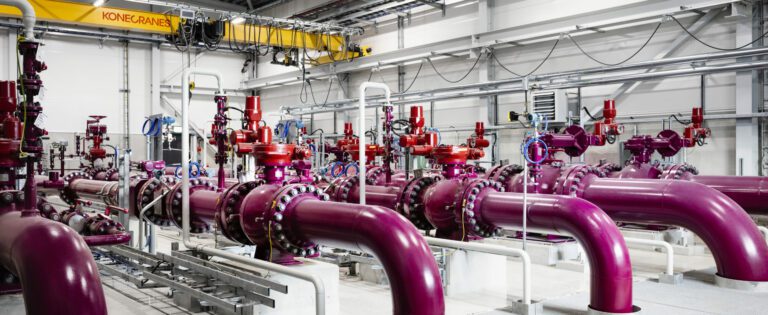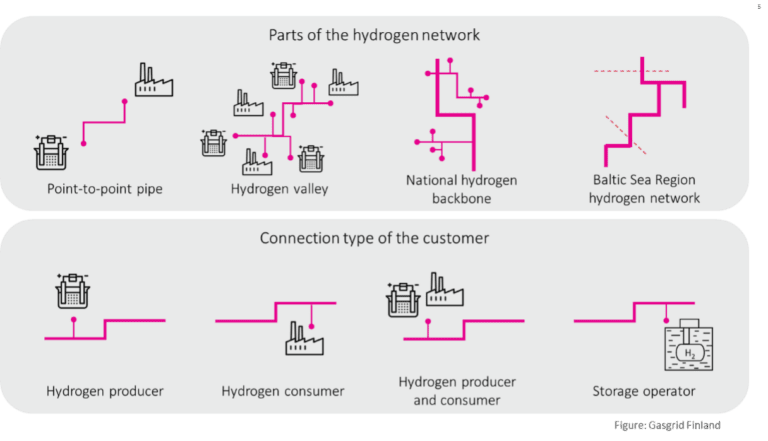
Gasgrid Finland is a Finnish state-owned company and transmission system operator (TSO) with system responsibility for the natural gas transmission system in Finland. As the Valley Coordinator of the BalticSeaH2 project, Gasgrid Finland steers the development of the hydrogen economy in the Main Valley between Southern Finland and Estonia. It contributes to establishing the Hydrogen Valley by advancing national and cross-border hydrogen infrastructure and market development.
Hydrogen mandated pioneer of energy future
The Finnish Government has tasked Gasgrid Finland to promote the development of the national hydrogen infrastructure, international infrastructure cooperation, and the hydrogen market in the Baltic Sea region.
In the big picture, Gasgrid will build a hydrogen transmission pipeline connecting hydrogen producers and consumers in Finland and Europe. To strengthen energy self-sufficiency and security and promote the creation of hydrogen economy investments in Finland, Gasgrid has initiated several hydrogen infrastructure development projects in the Baltic Sea area (further information at the end).
Gasgrid is involved in development projects in the Baltic Sea region as part of the European Hydrogen Backbone initiative. If the projects proceed as planned, the hydrogen infrastructure in the Baltic Sea region could grow up to 5,000 km by 2030.
Cross-border hydrogen infrastructure creating hydrogen market around the Baltic Sea region

The Nordic-Baltic Hydrogen Corridor project aims to develop hydrogen infrastructure, connecting the Finnish hydrogen market with that of the Baltic countries, i.e., Estonia, Latvia, Lithuania, and Poland, enabling access to the European market in Germany by 2030. Parties of the project are the local TSOs in each country. Gasgrid’s share is mainly related to developing the hydrogen network covering the whole of Southern Finland and the market in the Baltic Sea region. The project supports the diversification of the energy supply and the accelerated introduction of renewable energy. As the hydrogen infrastructure continues to develop around the Baltic Sea, a vital hydrogen market area can also be created, which enables large-scale utilization of abundantly available and competitive renewable energy resources.
The project strongly supports the EU’s hydrogen strategy and the REPowerEU plan. In addition, the hydrogen corridor of the Nordic and Baltic Sea region supports several regional and EU climate goals, such as the EU’s Green Deal program and the Fit for 55 package.
In the project’s first phase, a pre-feasibility study will be conducted during the first half of 2024. Based on the study recommendations, a decision on the continuation of the project development will be made. The following phases in the project would include the engineering and permitting phase, construction, and commissioning.
Significant step forward through nomination as a Project of Common Interest by the European Commission
On November 28, 2023, the European Commission announced that the Nordic-Baltic Hydrogen Corridor (NBHC) and the two other infrastructure projects are included on its 6th list of European Projects of Common Interest (PCI). Following the ongoing scrutiny by the European Parliament and the Council, the list is expected to enter into force at the end of April this year.
By being part of the PCI list, the NBHC is deemed a critical cross-border infrastructure project that will contribute to the EU’s energy independence and climate targets and establish an affordable, secure, and sustainable European energy system. The PCI status will support the NBHC’s realization of a large-scale onshore hydrogen pipeline infrastructure in the Baltic Sea Region by enabling simplified permitting processes and the possibility of applying for funding from the EU’s Connecting Europe Facility program.
Developments towards a regional hydrogen valley
While the NBHC creates hydrogen markets around the Baltic Sea region, it also supports the hydrogen economy development on a local scale. Regional hydrogen valleys are expected to be created around the Baltic Sea region. In the future, these separate hydrogen valleys will be connected to be part of the national infrastructures. BalticSeaH2 project advances the development of the world’s first cross-border hydrogen valley, BalticSeaH2 Valley, in which the planned pipeline infrastructure enables the physical connection between hydrogen producers and consumers in Southern Finland and Estonia. The pre-conditions for this development are suitable: cross-border methane transmission pipeline infrastructure, electricity grid, and active maritime traffic are already in place.

Gasgrid advances the development plans of the pipeline infrastructure in southern parts of Finland according to the market actors’ demands and considering the future growth potential. As a part of the BalticSeaH2 project, Gasgrid advances pipeline infrastructure planning by discovering the technical potential to repurpose existing methane pipelines for hydrogen and by developing pipeline connection principles for hydrogen producers and consumers to connect to the hydrogen network.
The hydrogen network enables the transmission of hydrogen from one location to another and provides short-term storage capacity and balancing between production and consumption. The hydrogen infrastructure supports sector integration in the energy system, i.e., coupling of industry, transport, and heating through electricity, heating, and gas networks. The BalticSeaH2 project partners aim to establish a ground for a future hydrogen market model that relies on a wide hydrogen transmission infrastructure, and leverages benefit from sector integration.
Gasgrid Finland Hydrogen Initiatives
Nordic Hydrogen Route is an initiative between Gasgrid Finland and Nordion Energi to accelerate the creation of a hydrogen economy by building up a cross-border hydrogen infrastructure in the Bothnian Bay region and an open hydrogen market by 2030. The Nordic Hydrogen Route aims to drive decarbonization and support regional green industrialization, economic development, and European energy independence. The companies seek to develop a network of pipelines that would effectively transport energy from producers to consumers to ensure they have access to an open, reliable, and safe hydrogen market.
The Nordic Hydrogen Route will drive decarbonization, support regional green industrialization, economic development, and European energy independence. In addition, the Nordic Hydrogen Route will accelerate the creation of a hydrogen economy and new investments to support the European energy transition and increase access to green and competitive domestic energy.
The Baltic Sea Hydrogen Collector development project explores the possibilities of building an offshore hydrogen pipeline connecting Finland, Sweden, and Germany to produce and store clean and sustainable hydrogen. Gasgrid focuses primarily on enabling the utilization of wind power in Finland’s maritime areas and the development of the market in the Baltic Sea region.
The parties in the project are Gasgrid Finland, Nordion Energi, industrial companies OX2, and Copenhagen Infrastructure Partners.
The companies have agreed to study the possibility of developing a new large-scale offshore hydrogen pipeline infrastructure connecting Finland, Sweden, and Central Europe to produce clean and sustainable hydrogen for Europe’s needs.
BHC aims to connect Finland and Sweden to Åland and Germany by 2030. The offshore project may also be connected to other energy islands, such as Gotland and Bornholm in Sweden and Denmark.